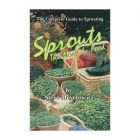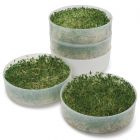Alfalfa Sprouts Organic
Homegrown sprouts are a healthy addition to any salad or sandwich year-round. Growing your own sprouts is also a great way to get your gardening fix through the cold days of winter! Easy to grow in a mason jar or our handy sprouter. Alfalfa sprouts contain a concentrated amount of certain vitamins and minerals such as calcium, vitamin K and vitamin C. Alfalfa sprouts contain just 8 calories and 0 grams of fat per cup. You should rinse alfalfa sprouts thoroughly under running water for one to two minutes and allow them to drain before eating them. Add rinsed alfalfa sprouts to a green salad or add them to a sandwich or burger. Approx. 475 seeds/gram.
View Common Uses for Sprouts and Sprouts Recipes online here.
Scroll down for more details and growing information.

Details
Growing Information
Directions:
Distribute evenly a very thin layer of seed. The seeds will swell and require a lot of space. For proper germination, seeds should remain wet, but never submerged. Sprouting kits are designed to keep seeds moist, while draining away excess water. Rinse seeds two or four times each day for best results.
Sprouting in the dark will force the sprouts to elongate, while sprouting with exposure to light will have the added benefit of allowing the tiny plants to produce chlorophyll, turning them green for an added nutritional value.
Please Note: The tiny seedlings develop very fine, fuzzy root hairs that can sometimes be mistaken for mould. If you think you are growing mould, look closely at one of the seedlings to determine if it is simply the fuzzy root hairs that you are seeing.
Using a Sprouter:
Place desired seed in the topmost tiers leaving the bottom tier, the one that the others sit on, empty. The bottom tier is left empty for excess water collection. Remember, 1 tablespoon of small seed or two tablespoons of large seed is all that is needed.
Rinse seeds two to four times per day. Fill the top tier and allow water to seep through the layers and collect in the bottom tier. Dump excess water.
Place the cover of the sprouter on the topmost tier. Never seal with cover as some airflow is needed. Sealing with the cover increases the chance of mould.
Repeat steps 2 and 3 until desired sprout size is achieved. Different crops require different days to harvest but 2-7 days is the typical range.
Note: Wash entire sprouter between harvests. This decreases the chance of mould developing.





